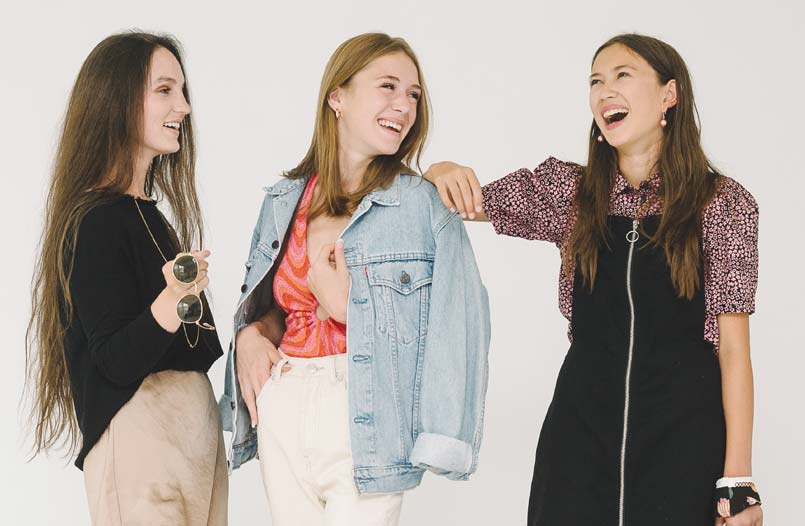
Courtney Genereaux, Logan Ramsay, Keira L.
Finding new uses for old clothing is always in style. Meet three local entrepreneurs who are leading the trend toward a new way of thinking.
Fashion is our chosen skin. It’s how we communicate who we are. And as clothing has become cheaper and fashion trends turn over more quickly, there are seemingly endless opportunities to change our looks, chameleon-like. But that “fast fashion” model, which produces cheap disposable clothing for consumers and healthy profit margins for retailers, comes at a tremendous cost to the planet, generating an alarming amount of pollution and waste.
The good news is that there is an alternative for fashion shoppers looking to reduce their carbon footprint and not break the bank. And so the practice of thrifting has moved front and centre.
If you’ve never heard of thrifting, think of it as the opposite of shopping for fast fashion: a way of reusing and recycling the clothes we already have while saving money and promoting a sustainable environment.
Three local entrepreneurs are offering a homegrown antidote to fast fashion. Alongside big players such as Poshmark and Depop, social media influencers like Emma Chamberlain and teen vloggers who are urging their viewers to “come thrift with me,” they’re part of a growing demographic of young internet-savvy resellers that pair their passion for fashion with an environmental conscience.
AN URGENT NEED FOR CHANGE
The statistics are staggering. According to Global Fashion Agenda, the clothing manufacturing industry accounts for 20 per cent of the world’s industrial water pollution due to the highly toxic chemicals used to process fabrics, making it the second most polluting industry on earth, next to oil.
Then there’s the waste: In 2015, 92 million tonnes of clothes globally were sent to landfill. Put differently, every second of every day, the equivalent of one garbage truck of textiles is either landfilled or incinerated, says the sustainability advocacy group, Fashion Takes Action. Closer to home, the Recycling Council of Ontario reports that 37 kilograms of textile waste per person ends up in Canadian landfills each year.
Recently, documentaries such as The True Cost and RiverBlue have shone a light on the fashion industry’s dirty secrets – beyond the massive environmental degradation and waste, production of 97 per cent of clothes is outsourced to low-cost countries, where workers are forced to work in unsafe and hazardous conditions for pitiful wages. In 2013, labour exploitation made front page news with the collapse of the Rana Plaza in Dhaka, Bangladesh, which killed over 1,100 workers, mostly women. And though Rana Plaza was the worst (but not the only) garment disaster in history, corporate bottom lines that continue to put profits over people mean that real systemic change is slow to come.
High-profile and pioneering designers such as Stella McCartney have been outspoken about the urgent need to create a new, sustainable and ethical textile and fashion industry that sources recycled materials and makes clothes that are made to last. Sadly, while there are a growing number of ethical designers and producers, the fast fashion industry (with names like Joe Fresh, George and H&M) is still a hungry one, refreshing their collections almost weekly.
A NEW GENERATION OF FASHIONISTAS
COURTNEY GENEREAUX
SEDIMENT APPAREL: “Saving Clothes from Landfill”
“I was that girl in school who wore the craziest outfits…” says businesswoman Courtney Genereaux, who launched Sediment Apparel in September 2019; one of her first sales was a thrifted item: a vintage Pierre Cavalli sweater that she’d had since she was 14. Parting with the beloved sweater “was really sad, but really exciting.”
Sediment Apparel is an online pre-loved clothing shop focused on promoting an ecoconscious mindset in the fashion world. It sources most items through donation and consignment programs and uses recycled packaging when available.
“The recycled packaging came in the beginning because it was saving money, but then I was like, ‘Wait, this is my brand. There are compostable mailers and recycled paper, but I might as well use an old cracker box. Why not?’”
She started the business on Instagram, then built her own website as a “fun thing to do,” and later diversified to other platforms: Besides her Facebook Marketplace account geared towards local shoppers, Courtney is also visible on reseller sites Poshmark (where she has 2,000 listed items and over 72,000 followers), Depop, Heroine and Grailed. While cross-posting makes it easy for customers to shop wherever they are, it’s also a huge amount of work. “I wouldn’t recommend it unless you have the passion for it,” says Courtney with a laugh. “But I love social media and I love the community of it.”
Despite the growing consumer demand for thrifted goods, Courtney’s very aware of the need to have a strong story behind her business. “The market for what I’m doing is becoming really saturated, so you need to be able to explain who you are and what you’re doing and what differentiates you from other people,” she says. “Otherwise, you’re just lost in a sea of people who are reselling online.”
“You need to be able to explain who you are and what you’re doing and what differentiates you from other people.”
COURTNEY GENEREAUX
Thrifting can be a bit like looking for buried treasure, and online sites offer an alternative to hours of swiping hangers in stores. “People don’t want to take the time to sift through all of the stuff out there, so if you can do that for them, there’s always value,” Courtney points out.
Any entrepreneur has to wear a lot of hats, and that’s no different for online thrift store owners. Besides sourcing product, there’s social media management, finances, taxes, shipping, not to mention styling: it’s critical to display the garments well, which takes time, a good eye – and lots of steaming. “You need to figure out how to make a garment look good,” says Courtney. “You have to look at yourself, do a hundred poses, and eventually figure out the right way to stand in a pair of jeans.”
With many new directions in her business life, Sediment has become more of a side hustle for Courtney, but she shows no signs of slowing down. “My whole life I’ve been in the upcycled/DIY/fixthings-before-you-get-rid-of-them mindset. People don’t always think that they can do much as a single person, but there is so much you can do. Something as small as buying second-hand. It’s not a closed loop by any means, but it’s a start to directing people on the right path.”
KEIRA L.
THE SILVER FASHIONISTA: “Original Clothing for Original Style”
Northumberland teen Keira L. is a “girl who spends time admiring scraps of fabric, taking photos of clothes and has a sewing machine instead of Tik-Tok.” She’s also the entrepreneur and designer behind The Silver Fashionista, where she upcycles clothing and gently used fabric to design one-of-a-kind outfits for kids and teens ages 6 to 14, though she has plans to make larger sizes to expand her clientele.
Keira started her blog in July 2020 and launched her business this past March because she was “obsessed with fashion.” She wanted to find like-minded community, as well as show the clothes she’d sewn to others. She also loves to write. With blog posts such as “Outfit ideas for when you’re running very, very late,” “One minute outfit challenge,” and “Finding your style, the confidence to rock it and more,” alongside interviews with Canadian experts in fashion and beauty, including Jules Grieve, Ali de Bold and Tracy Peart, Keira is well on her way to building both community and her brand.
Despite her young age, her blog has an original style (lots of pink, polka dots and bling) and a distinctive voice that showcases her passion for design, fashion and sewing. It’s not surprising to hear her say that she’s loved fashion since she was little. She learned to sew at daycare when she was five, then at eight she took her first class; shortly after, she got her first sewing machine. Her first piece of clothing was a cotton smock dress with a ruffle at the bottom.
“I started sewing more consistently when I started my blog because I wanted more pieces to be able to show. And then this year, I did a lot of experimenting, hoping it would work.” She adds, “Upcycling, which I’ve been doing for my business, is a lot easier than regular sewing because most of the time you already have a base…so I’ll take a dress and turn it into a shirt.”
Thrifting is at the core of her business model, either through donations, her own closet, or store finds. “It’s much more affordable than buying clothes from the mall, and I could really experiment with sewing and upcycling,” says Keira. “It’s a good way for me to get fabric and try out new ideas.”
Most of Keira’s sales come through her blog, though she’s also made some custom orders. She originally wanted to sell her clothes in person at gift or farmers’ markets, but the pandemic forced her to sell online, and she’s since experienced a crash course on business-building.
“I think clothing is a great way to brighten up your day a little bit, and I’m hoping that with my designs other kids will feel the same way.”
KEIRA L.
There are so many small businesses online that Keira wondered how anybody was ever going to find hers among the “millions” of others. “So I’ve had to learn a lot about marketing and promoting to get my business and message across,” she says, “and the importance of having a strong brand that separates me from other businesses. My brand is about taking second-hand clothing and using it to create something one-of-a-kind. And I recently created the tagline ‘Original clothing for original style.’”
She adds, “My designs are cheerful and stylish with fun prints and happy colours. I think clothing is a great way to brighten up your day a little bit, and I’m hoping that with my designs other kids will feel the same way.”
LOGAN RAMSAY
FOUND LINEN: “A great alternative”
Logan Ramsay, the entrepreneur behind Instagram reseller Found Linen, was born with an eye for style.
“When I was a kid, I had a fashionista birthday party, and I loved Paris and Fashion Week. And then when I went to high school, I got super into what was really trendy and dressed like my peers were dressing.” As she moved through Grades 11 and 12, she refined her approach and began to wear things that were not only comfortable but also looked good and adhered to her own fashion sense.
Logan is still new to the reselling universe, having just launched her thrifting business in May 2021, and she’s still developing her brand (while juggling two summer jobs and a return to university this fall). Like Courtney, she sees her business as providing a service, offering good-quality pieces that she genuinely likes. “People see that the items have been curated and thoughtfully put together, and they respond to that.” She adds that an “aesthetically pleasing Instagram account” that reflects her own personal style has helped shoppers move towards more sustainable options.
And what skill is most important for running an online fashion business? “With any business or entrepreneurial endeavour, my word would definitely be resilient,” she says. “Like if I do a drop and people don’t buy right away, that can be discouraging, so you definitely need to have that resilience and keep going.”
While starting a business during the pandemic is uniquely challenging (because the thrift stores were closed, Logan built her inventory from her own closet and then moved on to neighbours and family), she definitely experienced some unexpected benefits. Launching during a lockdown when teenagers were searching for something new to wear but didn’t want to buy fast fashions online gave Logan a chance to “monopolize” that market for a short time. “It worked great,” she says. “Some of my customers even said, ‘I’m so happy you’re doing this during COVID … and you’re a great alternative.’”
While thrifting was once seen as an economic necessity, now it’s gone mainstream. And there’s the added bonus of directing a few more pieces of clothing away from landfill and into closets.
“Thrifting is a really good way to find older pieces that can still be trendy today and are probably even more comfortable because they’ve been lived in,” Logan says.
She adds that it offers a great way for teens to experiment with their style and still fit in with their peers. “When you go thrifting you’re going to find something that’s one-of-a-kind. I think that gives so much opportunity because if you see it and like it, you can get it and style it whatever way you want. And that, in itself, is creating your own style.”
Story by:
Fiona Campbell
Photography by:
Tara McMullen


